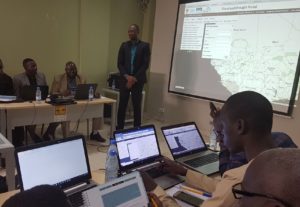Climate Smart Water – the road to resilience
Two tropical cyclones hit south eastern Africa in the same season this year – this is unheard of and the resulting natural disaster is the worst to hit the region in two decades. Ever-worsening storms and climate change are destroying people’s lives, especially the most vulnerable.
Climate hazards are natural events in weather cycles, however climate variability and change is exacerbating these cycles. According to the United States Geological Survey (USGS), higher global surface temperatures are increasing storm intensity and the possibility of more droughts. As more water vapor evaporates into the atmosphere it becomes fuel for the development of more powerful storms. More heat in the atmosphere and warmer ocean surface temperatures leads to increased wind speeds experienced in tropical storms.
The reality is with increasing climate variability and change, events such as storms and precipitation and flooding, drought, increased temperature and rising sea levels and the resulting impacts of flooding, water scarcity, groundwater depletion and water quality degradation are becoming increasingly common, more severe and less predictable. In the past, climate change conversations were mostly isolated from other threatening issues but currently, this trend is changing. The high risk as a result of the hydrological uncertainties posed by climate change has caused many countries, organisations and other stakeholders to realize it’s about time to start adapting to a warming world.
Climate resilience needs to be built and coordinated at the basin, city and utility level to ensure adaptation measures for water systems are effective and integrate with other urban services. Water utilities, in particular, need to have sustainable and resilient water resources management to ensure water supply continuity and to fulfill their responsibility to deliver safe and secure water to their customers.
Climate impacts on water utilities
Utilities tend to suffer from water quality and quantity issues, damaged infrastructure, including storm water and wastewater facilities due to the impacts of events such as increases in temperature, floods, storms and droughts. However, climate change is only part of the picture; water quality and supply is also affected by other factors including the type of water body, the pollutant of concern, the hydrological regime, and many other possible sources of pollution. Water supply systems need to be resilient in both current levels of climatic variability and to future changes.
Adaptation through water safety planning
Due to the global challenges faced with the changing weather, most utilities have realized that planning is key in preparing for the future and so are currently building their resilience through several preventive and planning approaches. Amongst such approaches is the Water Safety Plan (WSP) approach which offers an entry point for water utilities to consider climate change impacts.
A WSP provides a simple robust framework for water utilities to make climate resilience assessments and to plan for progressive adaptation to climate change and current challenges, such as changing input parameters, in fulfilling their provision as a water service provider.
Through the Implementing climate resilient water safety planning to improve water supply and public health (Climate Resilient Water Safety Plans) project in selected water utilities in Africa, IWA with support from OFID is assisting utilities plan and adapt to climate change events.
 |
There have been recent workshops in Kenya, Ghana, Burkina Faso and Senegal led by IWA which are supporting utilities in these countries to develop water safety plans which are climate resilient. |
Supported by the right information and tools, climate change information can be better integrated into planning and management procedures, such as WSP. This includes using tools from the Flood and Drought Portal which was developed as part of the Flood and Drought Management Tools project.
To help guide utilities on how best to use these tools, IWA has developed a set of strategic recommendations for water utilities. These recommendations explain 1) why and how water utilities can integrate climate change impacts into planning and management of water resources, specifically through WSPs; and 2) How to use the Flood and Drought Portal to better include climate data and information into WSP, ensuring its climate resilience.
With 20% of the world’s population living in river basins that are likely to be affected by increased climate hazard by the 2080s, it is critical that the resilience and capacity to mitigate the impacts are strengthened to sustain economies, society and the environment. Water resources are fundamental to the provision of drinking water, for industrial and agricultural use and ensuring the evolution of ecosystems. For water utilities, adaptation to a changing environment is a necessity to ensure water supply continuity and to fulfill their responsibility to deliver safe and secure water to their customers.
To support utilities in their journey to greater climate resilience, IWA is providing a toolkit offering the latest resources, knowledge and tools developed, co-designed and validated in collaboration with different end users.
| Webinar – 20 June 2019
Managing climate risks: the tale of two water utilities |
| Learn more on IWA Climate Smart Water Utilities here |
.

